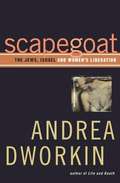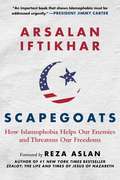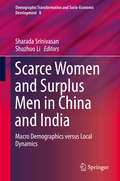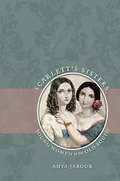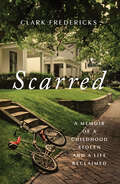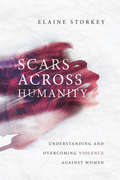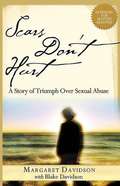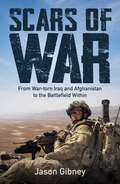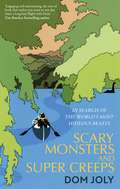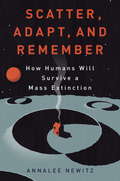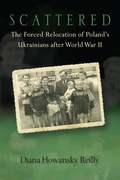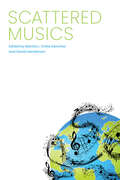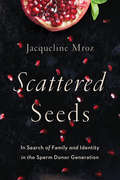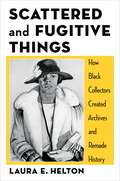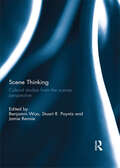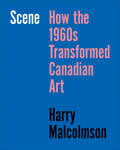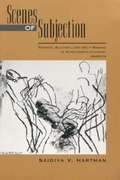- Table View
- List View
Scapegoat: The Jews, Israel, and Women's Liberation
by Andrea DworkinThe author writes about her views on male chauvinism, anti-Jewish attitudes, and the remedial measures to combat the problems faced by women and Jews.
Scapegoats: How Islamophobia Helps Our Enemies and Threatens Our Freedoms
by Reza Aslan Arsalan IftikharWhen a murderous psychopath goes on a killing spree, law enforcement officials and the media never make his religion the central issue?unless he happens to be a Muslim. Then it sets off another frenzied wave of commentary about the inherent evils that lurk within the Muslim faith. From Fox News talking heads, who regularly smear Muslim leaders as secret terrorists, to Bill Maher, who has made Islam a routine target, it has become widely acceptable to libel a religion with a following of over 1.5 billion people?nearly one-quarter of the world’s population. Now popular commentator Arsalan Iftikhar?better known as ?The Muslim Guy”?offers a spirited defense of his faith that is certain to win him wide acclaim?and yes, another round of overheated scolding from the usual media quarters. Iftikahr’s spirited defense of his faith is certain to hit a chord during the 2016 campaign season, as politicians and pundits vie to be the toughest on the block when it comes to escalating the hostilities in the Middle East, often demonizing Islam in the process. With his witty and levelheaded demeanor, the author will cut through all the sound and fury as a voice of sanity and reason.
Scarce Women and Surplus Men in China and India
by Sharada Srinivasan Shuzhuo LiThis volume documents how families, communities and some groups (single men, young 'scarce' women, parents) adapt and adjust to recent demographic shifts in China and India. It discusses how demographic change interacts with other processes of change, including changes with respect to economic development and globalization, gender, class, caste, families, migration and work. The chapters offer micro-level analyses contextualized in larger processes of change and push further existing understandings of the consequences of the demographic imbalance between men and women in China and/or India, particularly from a gender perspective. As such this book will be of interest to scholars and students in population studies, sociology, international development, gender studies, and Asian studies.
Scarlet and Black, Volume Three: Making Black Lives Matter at Rutgers, 1945-2020
by Edward White Joseph Williams Beatrice J. Adams Tracey Johnson Pamela N. Walker Meagan Wierda Roberto C. Orozco Carie Rael Brooke A. Thomas Ian Gavigan Kaisha Esty Whitney Fields Jesse Bayker Kenneth Morrissey Joseph Kaplan Lynda DexheimerThe 250th anniversary of the founding of Rutgers University is a perfect moment for the Rutgers community to reconcile its past, and acknowledge its role in the enslavement and debasement of African Americans and the disfranchisement and elimination of Native American people and culture. Scarlet and Black, Volume Three, concludes this groundbreaking documentation of the history of Rutgers’s connection to slavery, which was neither casual nor accidental—nor unusual. Like most early American colleges, Rutgers depended on slaves to build its campuses and serve its students and faculty; it depended on the sale of black people to fund its very existence. This final of three volumes concludes the work of the Committee on Enslaved and Disenfranchised Population in Rutgers History. This latest volume includes essays about Black and Puerto Rican students' experiences; the development of the Black Unity League; the Conklin Hall takeover; the divestment movement against South African apartheid; anti-racism struggles during the 1990s; and the Don Imus controversy and the 2007 Scarlet Knights women's basketball team. To learn more about the work of the Committee on Enslaved and Disenfranchised Population in Rutgers History, visit the project's website at http://scarletandblack.rutgers.edu.
Scarlet and Black, Volume Two: Constructing Race and Gender at Rutgers, 1865-1945
by Joseph Williams Beatrice J. Adams Shauni Armstead Miya Carey Tracey Johnson Brenann Sutter Pamela N. Walker Meagan Wierda Caitlin Reed Wiesner Shari Cunningham Eri Kitada Jerrad P PacatteThe 250th anniversary of the founding of Rutgers University is a perfect moment for the Rutgers community to reconcile its past, and acknowledge its role in the enslavement and debasement of African Americans and the disfranchisement and elimination of Native American people and culture. Scarlet and Black, Volume 2, continues to document the history of Rutgers’s connection to slavery, which was neither casual nor accidental—nor unusual. Like most early American colleges, Rutgers depended on slaves to build its campuses and serve its students and faculty; it depended on the sale of black people to fund its very existence. This second of a planned three volumes continues the work of the Committee on Enslaved and Disenfranchised Population in Rutgers History. This latest volume includes: an introduction to the period studied (from the end of the Civil War through WWII) by Deborah Gray White; a study of the first black students at Rutgers and New Brunswick Theological Seminary; an analysis of African-American life in the City of New Brunswick during the period; and profiles of the earliest black women to matriculate at Douglass College. To learn more about the work of the Committee on Enslaved and Disenfranchised Population in Rutgers History, visit the project's website at http://scarletandblack.rutgers.edu
Scarlett's Sisters
by Anya JabourScarlett's Sisters explores the meaning of nineteenth-century southern womanhood from the vantage point of the celebrated fictional character's flesh-and-blood counterparts: young, elite, white women. Anya Jabour demonstrates that southern girls and young women faced a major turning point when the Civil War forced them to assume new roles and responsibilities as independent women. Examining the lives of more than 300 girls and women between ages fifteen and twenty-five, Jabour traces the socialization of southern white ladies from early adolescence through young adulthood. Amidst the upheaval of the Civil War, Jabour shows, elite young women, once reluctant to challenge white supremacy and male dominance, became more rebellious. They adopted the ideology of Confederate independence in shaping a new model of southern womanhood that eschewed dependence on slave labor and male guidance.By tracing the lives of young white women in a society in flux, Jabour reveals how the South's old social order was maintained and a new one created as southern girls and young women learned, questioned, and ultimately changed what it meant to be a southern lady.Scarlett's Sisters explores the meaning of nineteenth-century southern womanhood from the vantage point of the celebrated fictional character's flesh-and-blood counterparts: young, elite, white women. Anya Jabour demonstrates that southern girls and young women faced a major turning point when the Civil War forced them to assume new roles and responsibilities as independent women. Examining the lives of more than 300 girls and women between ages fifteen and twenty-five, Jabour traces the socialization of southern white ladies from early adolescence through young adulthood. By tracing the lives of these young women in a society in flux, Jabour reveals how the South's old social order was maintained and a new one created as southern girls and young women learned, questioned, and ultimately changed what it meant to be a southern lady.-->
Scarred: A Feminist Journey Through Pain
by L. Ayu SaraswatiPROSE Award Winner for Biography and AutobiographyNamed one of Library Journal's Best Books of 2023Winner, Next Generation Indie Book Awards - Women's NonfictionOffers thought-provoking theories and life-transforming ways to deal with painWhat can we ask of pain? How can we be more creative and courageous in carrying pain in our lives? In this genre-bending work that is equal parts memoir and scholarly criticism, L. Ayu Saraswati provides thought-provoking theories and life-transforming ways to understand pain, specifically in relation to feminism. Arguing that pain is not merely a state we are in, Scarred reframes pain as a “transnational feminist object,” something that we can carry across international borders. Drawing on her own experience traveling across twenty countries within just over a year, Saraswati aims to bring readers along on her journey so that they might ask themselves, “How can I live with pain differently?”By using pain as a lens of feminist analysis, Scarred allows us to chart how power produces and operates through pain, and how pain is embodied and embedded in relationships. Saraswati provides a heartfelt and engaging recount of her experiences while also pushing the boundaries of the respective fields her story engages with. She allows for renewed academic and personal insights to blossom by using a blend of transnational feminist theory, travel studies, and pain studies. Ultimately, Scarred invites us to reframe pain and ask how might we carry it in a more humane, life-sustaining, enchanting, and feminist way.
Scarred: A Memoir of a Childhood Stolen and a Life Reclaimed
by Clark FredericksA memoir of trauma and transformation by a man who was haunted by childhood abuse but who fought his way back—a journey from vengeance and prison to freedom and redemption. For a boy growing up in the 1970s, rural northern New Jersey was a year-round playground, filled with secret fishing holes, enchanted woods, and private trails to explore with friends. But this childhood idyll was snatched from Clark Fredericks by a man he regarded as a local hero: Dennis Pegg, the town&’s Boy Scout leader, a law enforcement officer with the Sussex County Sheriff&’s Department, and, as Fredericks would discover, a serial predator. Through his teenage years and young adulthood, Fredericks kept silent about the horrific abuse he experienced, turning to drugs, alcohol, gambling, and sex addiction to numb the memory. For decades, he remained tormented by shame, unable to share the secrets that were eating away at his psyche—until he violently confronted his abuser. At once heartbreaking and uplifting, Scarred is the story of a man who overcame the destructive aftereffects of violence and abuse that nearly destroyed him. Now an advocate for victims and a prominent voice in support of child abuse law reform, Fredericks powerfully illustrates the healing power of love and trust.
Scars Across Humanity: Understanding and Overcoming Violence Against Women
by Elaine StorkeyChristianity Today 2019 Book of the Year Award, Politics and Public Life Across the globe, acts of violence against women produce more deaths, disability, and mutilation than cancer, malaria, and traffic accidents combined. The truth is that violence on such a scale could not exist were it not structured in some way into the very fabric of societies and cultures themselves. It could not continue if it were not somehow supported by deep assumptions about the value of women, or some justification of the use of power. In many cultures such assumptions are reiterated every day in the absence of legal protection for women, or indifference toward issues of human rights. In Scars Across Humanity, Elaine Storkey offers a rigorously researched overview of this global pandemic. From female infanticide and child brides to domestic abuse, prostitution, rape, and honor killings, violence against women occurs at all stages of life, and in all cultures and societies. How and why has this violence become so prevalent? It seems ambitious to hope that we can find an answer to this question, but if violence to women is ever to be eliminated, we need to know what we are up against.
Scars Don't Hurt: A Story of Triumph Over Sexual Abuse
by Margaret Davidson Blake DavidsonFear gripped her and held her captive in a prison of traumatic gloom until she met someone who would change her life. Author Margaret Davidson reveals the secrets of her childhood and the key to liberty in her new release, Scars Don't Hurt.
Scars of War: From War-torn Iraq and Afghanistan to the Battlefield Within
by Jason GibneyOne soldier&’s fight didn&’t end on the battlefield — it began there.This is the raw, haunting memoir of war, shame, survival, and the search for redemption. ________________________________________ At just seventeen, Jason Gibney enlisted in the Australian Defence Force, full of vigour and a thirst for adventure. Over the next decade, he served in Iraq, Afghanistan&’s deadly Chora Valley, and during the heartbreaking fall of Kabul in 2021. His missions included fierce firefights with the Taliban and a devastating role as an interpreter during the chaotic civilian evacuations. His final role in the evacuation of Kabul was to drag screaming, visa-denied Afghans to their fate, men he could understand, whose death sentences he could hear in their own words. In this searing memoir, he relives the brutalities of combat and the invisible wounds that followed — panic attacks, flashbacks, and a crushing sense of guilt. Diagnosed with PTSD and discharged, his war didn&’t end — it simply changed form. Scars of War charts his long, painful journey through trauma, shame, rage, and finally, the beginning of healing. This isn&’t a tale of heroism or closure. It&’s about what happens when the medals don&’t match the memories. When the politicians walk away, but you can&’t. And when the only way out is through. Brave, blisteringly honest, and heartbreakingly human, Scars of War is a call to understand what we ask of our soldiers — and what they carry home.&‘"In that moment, I wasn&’t a soldier — I was a monster dragging a man to his death.&” &“A true story of modern war like no other — honest, enraging, and unforgettable.&”
Scars of War: The Politics of Paternity and Responsibility for the Amerasians of Vietnam (Borderlands and Transcultural Studies)
by Sabrina ThomasBest First Book Award from the History Honor Society, Phi Alpha ThetaScars of War examines the decisions of U.S. policymakers denying the Amerasians of Vietnam—the biracial sons and daughters of American fathers and Vietnamese mothers born during the Vietnam War—American citizenship. Focusing on the implications of the 1982 Amerasian Immigration Act and the 1987 Amerasian Homecoming Act, Sabrina Thomas investigates why policymakers deemed a population unfit for American citizenship, despite the fact that they had American fathers. Thomas argues that the exclusion of citizenship was a component of bigger issues confronting the Nixon, Ford, Carter, and Reagan administrations: international relationships in a Cold War era, America&’s defeat in the Vietnam War, and a history in the United States of racially restrictive immigration and citizenship policies against mixed-race persons and people of Asian descent. Now more politically relevant than ever, Scars of War explores ideas of race, nation, and gender in the aftermath of the Vietnam War. Thomas exposes the contradictory approach of policymakers unable to reconcile Amerasian biracialism with the U.S. Code. As they created an inclusionary discourse deeming Amerasians worthy of American action, guidance, and humanitarian aid, federal policymakers simultaneously initiated exclusionary policies that designated these people unfit for American citizenship.
Scary Monsters and Super Creeps: In Search of the World's Most Hideous Beasts
by Dom JolyDom Joly sets off round the world, but this time he's not looking to holiday in a danger zone - he's monster hunting. Ever since he was given a copy of Arthur C. Clarke's Mysterious World for his ninth birthday Dom has been obsessed with the world of cryptozoology - monster hunting - and in Scary Monsters and Super Creeps he heads to six completely different destinations to investigate local monster sightings. He explores the Redwood Curtain in northern California in search of Sasquatch; in Canada he visits Lake Okanagan hoping to catch a glimpse of a thirty-foot snake-like creature called Ogopogo; and near Lake Tele in Congo he risks his life tracking the vegetarian sauropod Mokele-mbembe. Naturally he heads to Loch Ness - but for this hunt he has his family in tow; he treks across the Khumbu Valley in Nepal looking for Yeti; and in the hills above Hiroshima in Japan he enlists the help of a local man to find the Hibagon, a terribly smelly 'caveman ape'. Are the monsters all the product of fevered minds, or is there a sliver of truth somewhere in the madness? Either way, the search gives Dom an excuse to dive into six fascinating destinations on a gloriously nutty adventure. In typically hilarious and irreverent fashion, Dom explores the cultures that gave rise to these monster myths and ends up in some pretty hairy situations with people even stranger than the monsters they are hunting.
Scary Monsters and Super Creeps: In Search of the World's Most Hideous Beasts
by Dom JolyDom Joly sets off round the world, but this time he's not looking to holiday in a danger zone - he's monster hunting. Ever since he was given a copy of Arthur C. Clarke's Mysterious World for his ninth birthday Dom has been obsessed with the world of cryptozoology - monster hunting - and in Scary Monsters and Super Creeps he heads to six completely different destinations to investigate local monster sightings. He explores the Redwood Curtain in northern California in search of Sasquatch; in Canada he visits Lake Okanagan hoping to catch a glimpse of a thirty-foot snake-like creature called Ogopogo; and near Lake Tele in Congo he risks his life tracking the vegetarian sauropod Mokele-mbembe. Naturally he heads to Loch Ness - but for this hunt he has his family in tow; he treks across the Khumbu Valley in Nepal looking for Yeti; and in the hills above Hiroshima in Japan he enlists the help of a local man to find the Hibagon, a terribly smelly 'caveman ape'. Are the monsters all the product of fevered minds, or is there a sliver of truth somewhere in the madness? Either way, the search gives Dom an excuse to dive into six fascinating destinations on a gloriously nutty adventure. In typically hilarious and irreverent fashion, Dom explores the cultures that gave rise to these monster myths and ends up in some pretty hairy situations with people even stranger than the monsters they are hunting.
Scary Monsters and Super Creeps: In Search of the World's Most Hideous Beasts
by Dom JolyDom Joly sets off round the world, but this time he's not looking to holiday in a danger zone - he's monster hunting. Ever since he was given a copy of Arthur C. Clarke's Mysterious World for his ninth birthday Dom has been obsessed with the world of cryptozoology - monster hunting - and in Scary Monsters and Super Creeps he heads to six completely different destinations to investigate local monster sightings. He explores the Redwood Curtain in northern California in search of Sasquatch; in Canada he visits Lake Okanagan hoping to catch a glimpse of a thirty-foot snake-like creature called Ogopogo; and near Lake Tele in Congo he risks his life tracking the vegetarian sauropod Mokele-mbembe. Naturally he heads to Loch Ness - but for this hunt he has his family in tow; he treks across the Khumbu Valley in Nepal looking for Yeti; and in the hills above Hiroshima in Japan he enlists the help of a local man to find the Hibagon, a terribly smelly 'caveman ape'. Are the monsters all the product of fevered minds, or is there a sliver of truth somewhere in the madness? Either way, the search gives Dom an excuse to dive into six fascinating destinations on a gloriously nutty adventure. In typically hilarious and irreverent fashion, Dom explores the cultures that gave rise to these monster myths and ends up in some pretty hairy situations with people even stranger than the monsters they are hunting.
Scatter, Adapt, and Remember
by Annalee NewitzIn its 4.5 billion-year history, life on Earth has been almost erased at least half a dozen times: shattered by asteroid impacts, entombed in ice, smothered by methane, and torn apart by unfathomably powerful megavolcanoes. And we know that another global disaster is eventually headed our way. Can we survive it? How?As a species, Homo sapiens is at a crossroads. Study of our planet's turbulent past suggests that we are overdue for a catastrophic disaster, whether caused by nature or by human interference.It's a frightening prospect, as each of the Earth's past major disasters--from meteor strikes to bombardment by cosmic radiation--resulted in a mass extinction, where more than 75 percent of the planet's species died out. But in Scatter, Adapt, and Remember, Annalee Newitz, science journalist and editor of the science Web site io9.com explains that although global disaster is all but inevitable, our chances of long-term species survival are better than ever. Life on Earth has come close to annihilation--humans have, more than once, narrowly avoided extinction just during the last million years--but every single time a few creatures survived, evolving to adapt to the harshest of conditions. This brilliantly speculative work of popular science focuses on humanity's long history of dodging the bullet, as well as on new threats that we may face in years to come. Most important, it explores how scientific breakthroughs today will help us avoid disasters tomorrow. From simulating tsunamis to studying central Turkey's ancient underground cities; from cultivating cyanobacteria for "living cities" to designing space elevators to make space colonies cost-effective; from using math to stop pandemics to studying the remarkable survival strategies of gray whales, scientists and researchers the world over are discovering the keys to long-term resilience and learning how humans can choose life over death. Newitz's remarkable and fascinating journey through the science of mass extinctions is a powerful argument about human ingenuity and our ability to change. In a world populated by doomsday preppers and media commentators obsessively forecasting our demise, Scatter, Adapt, and Remember is a compelling voice of hope. It leads us away from apocalyptic thinking into a future where we live to build a better world--on this planet and perhaps on others. Readers of this book will be equipped scientifically, intellectually, and emotionally to face whatever the future holds.
Scattered
by Diana Howansky ReillyFollowing World War II, the communist government of Poland forcibly relocated the country's Ukrainian minority by means of a Soviet-Polish population exchange and then a secretly planned action code-named Operation Vistula. InScattered, Diana Howansky Reilly recounts these events through the experiences of three siblings caught up in the conflict, during a turbulent period when compulsory resettlement was a common political tactic used against national minorities to create homogenous states. Born in the Lemko region of southeastern Poland, Petro, Melania, and Hania Pyrtej survived World War II only to be separated by political decisions over which they had no control. Petro relocated with his wife to Soviet Ukraine during the population exchange of 1944–46, while his sisters Melania and Hania were resettled to western Poland through Operation Vistula in 1947. As the Ukrainian Insurgent Army fought resettlement, the Polish government meanwhile imprisoned suspected sympathizers within the Jaworzno concentration camp. Melania, Reilly's maternal grandmother, eventually found her way to the United States during Poland's period of liberalization in the 1960s. Drawing on oral interviews and archival research, Reilly tells a fascinating, true story that provides a bottom-up perspective and illustrates the impact of extraordinary historical events on the lives of ordinary people. Tracing the story to the present, she describes survivors' efforts to receive compensation for the destruction of their homes and communities.
Scattered Among the Nations: Photographs and Stories of the World's Most Isolated Jewish Communities
by Bryan Schwartz Jay Sand Sandy Carter“A beautifully presented book on Jewish diversity around the world . . . opens windows into lives from the hills of Portugal to the plains of Africa.” —The Jerusalem PostWith vibrant photographs and intricate accounts Scattered Among the Nations tells the story of the world’s most isolated Jewish communities in Africa, Asia, Latin America, the Former Soviet Union and the margins of Europe. Over two thousand years ago, a shipwreck left seven Jewish couples stranded off India’s Konkan Coast, south of Bombay. Those hardy survivors stayed, built a community, and founded one of the fascinating groups described in this book—the Bene Israel of India’s Maharasthra Province. This story is unique, but it is not unusual. We have all heard the phrase “the lost tribes of Israel,” but never has the truth and wonder of the Diaspora been so lovingly and richly illustrated. To create this amazing chronicle of faith and resilience, the authors visited Jews in thirty countries across five continents, hearing origin stories and family histories that stretch back for millennia.“Beautiful, even breathtaking . . . a Jewish (Inter) National Geographic, wisely reminding us that the strategies for survival of Jews in distant lands may be relevant to our own.” —Rabbi Lawrence Kushner, Emanu-El Scholar at Congregation Emanu-El of San Francisco and author of I’m God; You’re Not“This exquisite book is a gift to the Jewish people, dramatically stretching our understanding of ‘Jewish’ . . . A book to be savored, read and re-read, and transmitted from one generation to the next.” —Yossi Klein Halevi, Senior Fellow, Shalom Hartman Institute, Jerusalem
Scattered Musics
by Martha I. Chew Sánchez and David HendersonContributions by Nilanjana Bhattacharjya, Benjamin Burkhart, Ivy Chevers, Martha I. Chew Sánchez, Athena Elafros, William García-Medina, Sara Goek, David Henderson, Eyvind Kang, Junko Oba, Juan David Rubio Restrepo, and Gareth Dylan SmithIn Scattered Musics, editors Martha I. Chew Sánchez and David Henderson, along with a range of authors from a variety of scholarly backgrounds, consider the musics that diaspora and migrant populations are inspired to create, how musics and musicians travel, and how they change in transit. The authors cover a lot of ground: cumbia in Mexico, música sertaneja in Japan, hip-hop in Canada, Irish music in the US and the UK, reggae and dancehall in Germany, and more. Diasporic groups transform the musical expressions of their home countries as well as those in their host communities. The studies collected here show how these transformations are ways of grappling with ever-changing patterns of movement. Different diasporas hold their homelands in different regards. Some communities try to re-create home away from home in musical performances, while others use music to critique and redefine their senses of home. Through music, people seek to reconstruct and refine collective memory and a collective sense of place.The essays in this volume—by sociologists, historians, ethnomusicologists, and others—explore these questions in ways that are theoretically sophisticated yet readable, making evident the complexities of musical and social phenomena in diaspora and migrant populations. As the opening paragraph of the introduction to the volume observes, “What remains when people have been scattered apart is a strong urge to gather together, to collect.” At few times in our lives has that ever been more apparent than right now.
Scattered Seeds: In Search of Family and Identity in the Sperm Donor Generation
by Jacqueline MrozAs typical as donor-conceived children have become, with at least a million such children in the US alone, their experiences are still unusual in many ways. In Scattered Seeds, journalist and writer Jacqueline Mroz looks at the growth of sperm donation and assisted reproduction and how it affects the children who are born, the women who buy and use the sperm to have kids, and the sperm donors who donate their genetic material to help others procreate. With empathy and in-depth analysis, Scattered Seeds explores the sociology, psychology, and anthropology surrounding those connected with fertility procedures today and looks back at the history that brought us to this point.The personal stories in this book will put a human face on the issues and help to illuminate this country's controversial and troubling unregulated fertility industry-an industry that has been compared to the Wild, Wild West, where anything goes. What is the human cost of our country's unregulated fertility industry? How are the lives of sperm-donor families changed? Scattered Seeds will answer those questions, considering carefully the social and psychological dynamics surrounding those connected with fertility procedures today.
Scattered and Fugitive Things: How Black Collectors Created Archives and Remade History (Black Lives in the Diaspora: Past / Present / Future)
by Laura HeltonDuring the first half of the twentieth century, a group of collectors and creators dedicated themselves to documenting the history of African American life. At a time when dominant institutions cast doubt on the value or even the idea of Black history, these bibliophiles, scrapbookers, and librarians created an enduring set of African diasporic archives. In building these institutions and amassing abundant archival material, they also reshaped Black public culture, animating inquiry into the nature and meaning of Black history.Scattered and Fugitive Things tells the stories of these Black collectors, traveling from the parlors of the urban north to HBCU reading rooms and branch libraries in the Jim Crow south. Laura E. Helton chronicles the work of six key figures: bibliophile Arturo Schomburg, scrapbook maker Alexander Gumby, librarians Virginia Lee and Vivian Harsh, curator Dorothy Porter, and historian L. D. Reddick. Drawing on overlooked sources such as book lists and card catalogs, she reveals the risks collectors took to create Black archives. This book also explores the social life of collecting, highlighting the communities that used these collections from the South Side of Chicago to Roanoke, Virginia. In each case, Helton argues, archiving was alive in the present, a site of intellectual experiment, creative abundance, and political possibility. Offering new ways to understand Black intellectual and literary history, Scattered and Fugitive Things reveals Black collecting as a radical critical tradition that reimagines past, present, and future.
Scene Thinking: Cultural Studies from the Scenes Perspective
by Benjamin Woo, Stuart R. Poyntz and Jamie RennieHow is cultural activity shaped by the places where it unfolds? One answer has been found in the ‘scenes perspective’, a development within popular music studies that explains change and transformation within musical practices in terms of the social and institutional histories of scenes. Scene Thinking: Cultural Studies from the Scenes Perspective takes up this framework – and the mode of analysis that goes with it – as an important contribution to cultural analysis and social research more generally. In a series of focused case studies – ranging across practices like drag kinging, Bangladeshi underground music, urban arts interventions and sites like single performance venues, urban neighbourhoods in various states of gentrification, and virtual networks of game consoles in countless living rooms – the authors demonstrate how ‘scene thinking’ can enrich cultural studies inquiry. As a humanistic, empirically oriented alternative to network-based social ontologies, thinking in terms of scenes sensitizes researchers to complex, fluid processes that are nonetheless anchored and made meaningful at the level of lived experience. This book was originally published as a special issue of Cultural Studies.
Scene: How the 1960s Transformed Canadian Art
by Harry MalcolmsonThe 1960s transformed art in Canada. The Scene traces the remarkable reshaping of the Canadian art landscape during that era. Written by renowned art critic Harry Malcolmson, the book offers a captivating insider’s perspective on how a surge of artists, galleries, collectors, and critics propelled Canadian art into the global spotlight. Malcolmson identifies the catalysts that ignited this artistic renaissance, including an outpouring of pride in the country linked to Canada's Centennial, Expos ’67, and the Toronto City Hall. With rich anecdotes and insights, the book paints a comprehensive portrait of the era, while showcasing over twenty portraits of influential Canadian artists. Richly illustrated, the book illuminates the totality of the Scene’s evolution, and delves into the impact of Canadian nationalism and economic prosperity on the Scene. It examines the rise of contemporary institutions, such as the Art Gallery of Ontario and the National Gallery of Canada, capturing the emergence of a modern Canadian identity. Ultimately, The Scene stands as a unique testament to a pivotal moment in cultural history, capturing the essence of the most impactful decade in the history of art in Canada.
Scenes Of Subjection: Terror, Slavery, And Self-making In Nineteenth-century America
by Saidiya HartmanIn this provocative and original exploration of racial subjugation during slavery and its aftermath, Saidiya Hartman illumines the forms of terror and resistance that shaped black identity. <P><P>Scenes of Subjection examines the forms of domination that usually go undetected; in particular, the encroachments of power that take place through notions of humanity, enjoyment, protection, rights, and consent. By looking at slave narratives, plantation diaries, popular theater, slave performance, freedmen's primers, and legal cases, Hartman investigates a wide variety of "scenes" ranging from the auction block and minstrel show to the staging of the self-possessed and rights-bearing individual of freedom. <P><P>While attentive to the performance of power—the terrible spectacles of slaveholders' dominion and the innocent amusements designed to abase and pacify the enslaved—and the entanglements of pleasure and terror in these displays of mastery, Hartman also examines the possibilities for resistance, redress and transformation embodied in black performance and everyday practice. <P><P>This important study contends that despite the legal abolition of slavery, emergent notions of individual will and responsibility revealed the tragic continuities between slavery and freedom. Bold and persuasively argued, Scenes of Subjection will engage readers in a broad range of historical, literary, and cultural studies.
Scenes and Communities in the City
by Marta KlekotkoThis open access book addresses the problem of creation and reproduction processes of contemporary urban communities, as well as cultural mechanisms and factors of these processes. Rejecting both the environmental determinism, and cultural reductionism of community studies, the book assumes that the postmodern city is a space of diverse urban communities that go far beyond the traditional concept of neighbourhood as well as personal and imagined communities, and thus proposes to comprehend urban community as social practice embedded in urban space. The book applies the Theory of Social Practice and the Theory of Scenes and develops the concept of socio-cultural opportunity structures in order to explain how cultural practices of individuals and symbolic dimensions of territory interact, leading to (re)production of various forms of urban community. It is assumed that culture in general and symbolic meanings of territory in particular, play a crucial role in the process of (re)production of urban communities, that this process takes place in collective cultural consciousness and is mediated by territorially embedded cultural practices of individuals. The book overcomes theoretical gaps in classical community studies and develops a new perspective on urban communal processes based on the analysis of social practices in urban cultural scenes.
